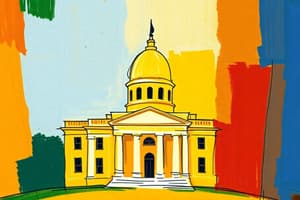Podcast
Questions and Answers
What may be included in the Terms of Reference of the Commission?
What may be included in the Terms of Reference of the Commission?
- Previous constitutional reviews (correct)
- Analysis of local government structures
- A historical overview of the Constitution (correct)
- Recommendations for judicial appointments
Which appendix would you refer to for a list of Presidents and Prime Ministers of India?
Which appendix would you refer to for a list of Presidents and Prime Ministers of India?
- Appendix II: Subjects of Union, State and Concurrent Lists
- Appendix V: Presidents, Vice-Presidents, Prime Ministers, etc. (correct)
- Appendix III: Table of Precedence
- Appendix I: Articles of the Constitution
What is the primary purpose of the Model Code of Conduct Relating to Elections?
What is the primary purpose of the Model Code of Conduct Relating to Elections?
- To define the scope of legislative powers
- To outline the duties of elected officials post-election
- To regulate the allocation of resources by the state
- To ensure fair campaigning and electoral processes (correct)
Which legislative acts provide guidelines on the representation of people in India?
Which legislative acts provide guidelines on the representation of people in India?
How many articles does the Constitution of India contain as per the appendices?
How many articles does the Constitution of India contain as per the appendices?
What significant change occurred in 1858 regarding British governance in India?
What significant change occurred in 1858 regarding British governance in India?
Which act marked the beginning of British governmental oversight over the East India Company?
Which act marked the beginning of British governmental oversight over the East India Company?
What was established by the Regulating Act of 1773 in relation to the governance structure in India?
What was established by the Regulating Act of 1773 in relation to the governance structure in India?
How did the Regulating Act of 1773 change the relationship between Indian presidencies?
How did the Regulating Act of 1773 change the relationship between Indian presidencies?
Which governor served as the first Governor-General of Bengal under the Regulating Act of 1773?
Which governor served as the first Governor-General of Bengal under the Regulating Act of 1773?
What year marked the official establishment of the Constitution of India?
What year marked the official establishment of the Constitution of India?
What was a consequence of the British Crown assuming control in 1858?
What was a consequence of the British Crown assuming control in 1858?
The term 'diwani' refers to which aspect concerning the East India Company's governance?
The term 'diwani' refers to which aspect concerning the East India Company's governance?
Which Indian leaders were nominated to Lord Canning's legislative council in 1862?
Which Indian leaders were nominated to Lord Canning's legislative council in 1862?
Which Act initiated the decentralization of legislative powers in India?
Which Act initiated the decentralization of legislative powers in India?
What recognition did the Indian Councils Act of 1861 provide regarding the 'portfolio' system?
What recognition did the Indian Councils Act of 1861 provide regarding the 'portfolio' system?
What was the maximum duration of an ordinance issued by the Viceroy during an emergency as per the Indian Councils Act of 1861?
What was the maximum duration of an ordinance issued by the Viceroy during an emergency as per the Indian Councils Act of 1861?
What power was granted to the legislative councils by the Indian Councils Act of 1892?
What power was granted to the legislative councils by the Indian Councils Act of 1892?
Who could nominate non-official members to the Central Legislative Council according to the Indian Councils Act of 1892?
Who could nominate non-official members to the Central Legislative Council according to the Indian Councils Act of 1892?
Which of the following was not a feature of the Indian Councils Act of 1892?
Which of the following was not a feature of the Indian Councils Act of 1892?
Which legislative councils were established as a result of the Indian Councils Act of 1861?
Which legislative councils were established as a result of the Indian Councils Act of 1861?
What primary role did the Assembly have in relation to the British Parliament's laws?
What primary role did the Assembly have in relation to the British Parliament's laws?
When did the Constituent Assembly conclude its task of making the Constitution?
When did the Constituent Assembly conclude its task of making the Constitution?
Who chaired the Assembly when it met as a legislative body?
Who chaired the Assembly when it met as a legislative body?
What significant event occurred on January 24, 1950, related to the Constituent Assembly?
What significant event occurred on January 24, 1950, related to the Constituent Assembly?
Which of the following did the Constituent Assembly NOT adopt?
Which of the following did the Constituent Assembly NOT adopt?
How many total sessions did the Constituent Assembly hold?
How many total sessions did the Constituent Assembly hold?
What was the total expenditure incurred on making the Constitution?
What was the total expenditure incurred on making the Constitution?
What happened to the strength of the Assembly after the Muslim League members withdrew?
What happened to the strength of the Assembly after the Muslim League members withdrew?
What significant change did the Charter Act of 1833 implement regarding the powers of governors?
What significant change did the Charter Act of 1833 implement regarding the powers of governors?
What was the role of the East India Company after the Charter Act of 1833?
What was the role of the East India Company after the Charter Act of 1833?
Which of the following features was introduced by the Charter Act of 1853?
Which of the following features was introduced by the Charter Act of 1853?
What impact did the Charter Act of 1853 have on civil servants in India?
What impact did the Charter Act of 1853 have on civil servants in India?
What provision did the Charter Act of 1833 include regarding Indians in employment under the Company?
What provision did the Charter Act of 1833 include regarding Indians in employment under the Company?
What indication did the Charter Act of 1853 give regarding the future of the Company's rule in India?
What indication did the Charter Act of 1853 give regarding the future of the Company's rule in India?
What was the result of the introduction of the Indian Legislative Council by the Charter Act of 1853?
What was the result of the introduction of the Indian Legislative Council by the Charter Act of 1853?
Which committee was appointed to address the selection of civil servants after the Charter Act of 1853?
Which committee was appointed to address the selection of civil servants after the Charter Act of 1853?
Study Notes
Historical Background
- The British arrived in India in 1600 as traders with the East India Company, which gained trading rights through a charter from Queen Elizabeth I.
- By 1765, the Company obtained 'diwani' rights, granting control over revenue and civil justice in Bengal, Bihar, and Orissa.
- Following the Sepoy Mutiny in 1858, the British Crown took direct control over India, a governance style that lasted until Indian independence on August 15, 1947.
- The need for a Constitution arose with independence, leading to the formation of a Constituent Assembly in 1946, culminating in the Constitution coming into effect on January 26, 1950.
The Company Rule (1773–1858)
-
Regulating Act of 1773:
- First British Government attempt to control the East India Company's affairs.
- Established the Governor of Bengal as the Governor-General of Bengal and created an Executive Council.
- Ended the Company's role as a commercial entity; its territories were held in trust for the British Crown.
-
Charter Act of 1833:
- Separated legislative and executive functions of the Governor-General’s council.
- Introduced an open competition for civil services but was met with opposition.
- Laid the groundwork for future representative institutions.
-
Charter Act of 1853:
- Established a separate legislative council for the Governor-General, functioning as a mini-Parliament.
- Allowed Indians to participate in the civil service recruitment.
- Initiated regional legislative councils and recognized the portfolio system for the Viceroy's council.
The Crown Rule (1858–1947)
- Indian Councils Act of 1892:
- Increased non-official member representation in both Central and provincial legislative councils while maintaining an official majority.
- Empowered legislative councils to discuss budgets and raise questions to the executive.
Constituent Assembly Functions
- The Constituent Assembly functioned as both a legislative body and the body to draft the Constitution, holding 11 sessions over nearly 2 years.
- Significant achievements include:
- Ratification of membership to the Commonwealth in May 1949.
- Adoption of the national flag (July 22, 1947), national anthem (January 24, 1950), and national song (January 24, 1950).
- Dr. Rajendra Prasad elected as the first President of India.
Creation of the Indian Constitution
- The Assembly analyzed over 60 foreign constitutions and deliberated for 114 days on the Draft Constitution.
- Total expenditure on the Constitution drafting was ₹64 lakh.
- After the Constitution's formal adoption on January 26, 1950, the Assembly continued as the provisional Parliament until the first general elections (1951–52).
Constitutional Amendments and Structure
- Various aspects of the Constitution draw influence from British rule, encapsulating historical legislative frameworks.
- Key areas of concern and recommendations often emerge from the perception and understanding of the Constitution’s effectiveness over time.
Additional Resources
- Appendices provide documentation including constitutional articles, amendments, table of precedence, and historical figures in Indian polity, alongside past UPSC exam questions for reference and practice.
Studying That Suits You
Use AI to generate personalized quizzes and flashcards to suit your learning preferences.
Related Documents
Description
Explore the key terms, insights, and recommendations from the Commission's review of the Constitution over fifty years. This quiz covers crucial articles, areas of concern, and earlier efforts aimed at constitutional amendments. Test your understanding of the framework and evolution of governance.




